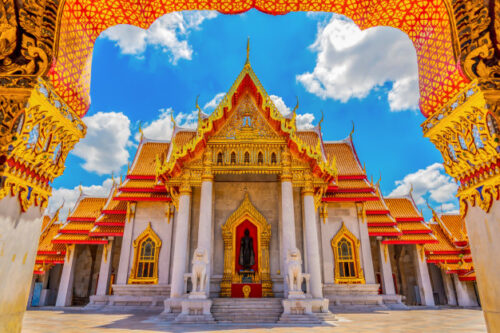Wat Benchamabophit or Benchamabophit Temple (Wat in Thai means temple) also known as the mable temple is one of the most visited temples in Bangkok, Thailand. Thousand of tourists visit the temple every year. In this blog, I will talk about Wat Benchamabophit and other attractions nearby the temple that you can also visit. These are Vimanmek Mansion, Ananta Samakhom Throne Hall, Phra Boromrup Song Ma (Equestrian Statue of Rama V), Mud Khana Ratsadon (People’s Party Rivet) and Chitralada Royal Project.
Table of Contents
Wat Benchamabophit Dusitwanaram Ratchawora Vihara
The temple was known as ‘Wat Laem’ or ‘Wat Saithong.’ After Rama V decided to build Dusit Palace, he ordered the temple to be renovated to be the palace’s main Buddhist site.
 Photo credit : freepik.com
Photo credit : freepik.com
The renovatoin was planned by Prince Narit which makes it one of the best-planned temples in Thailand. The temple is commonly known among tourists as ‘the Marble Temple’ due to its white Carrara marble ordination hall.
 Photo credit: discoverimages.com
Photo credit: discoverimages.com
The ubosot is regarded as ‘the perfect form of Thai architecture’ as well as the whole site of the temple. It attracts tourists both Thai and foreigners. The ordination hall also houses the full size replica of Phra Phuttha Shinnarat.
Vimanmek Mansion
Not far From Wat Benchamabophit, there is Vimanmek Mansion located nearby. The mansion is the world’s biggest teak wood mansion. It was first built on Si Chang island in Rama V’s reign but later it was relocated and completed in the Dusit palace in 1901. The mansion’s architecture is based on Victorian architecture with some elements from Thai architecture.
 Photo credit: naewna.com
Photo credit: naewna.com
The mansion is a L-shape building and there are 31 rooms for displaying Rama V and princes and princesses’ private collections such as the Green Chamber which is dedicated for silverware from China, Rama V’s private study on second floor, and bed chambers on the third floor. The most beautiful part of the mansion is the grand hall where the atmosphere is filled with gradeur.
 Photo credit: travel.mthai.com
Photo credit: travel.mthai.com
Ananta Samakhom Throne Hall
The throne hall is situated near the Equestrian Statue and Vimanmek Mansion. The construction began in 1907 in the reign of Rama V and completed in 1915, under the direction of Chao Phraya Yommarat (Pan Sukhum) and the italian Architect Mario Tamagno.
 Photo credit: tnews.co.th
Photo credit: tnews.co.th
The throne hall was built in Neo-Renaissance and Neo-Classic architecture with a rooftop dome. It is decorated with Carrara marble, imported from Italy. The throne hall ceilings are adorned with frescoes depicting the roayal duties of Ramas I-VI, painted by Carlo Riguli and Galileo Chini.
The throne hall now serves as the site for state ceremonies and exhibition hall for the permanent exhibiton ‘Silp haeng Phaendin’ (The Art of the Land) by the Queen Sirikit Institue.
Phra Boromrup Song Ma (Equestrian Statue of Rama V)
In front of Ananta Samakhom Throne Hall, you will see Phra Boromrup Song Ma (Equestrian Statue of Rama V). The people of Thailand built this statue to commemorate the 40th anniversary King Rama V’s ascent to the throne.
 Photo credit: tnews.co.th
Photo credit: tnews.co.th
It was modeled after the Equestrian Statue of Louis XIV. The equestrian statue was cast in France by famous French sculptor Georges Saulo of Fonderie Susse in the time of Rama V’s second Europe Grand Tour in 1918.
Nowadays, the Royal Plaza is a site of worship to Rama V, especially on Tuesday, which was Rama V’s birthday.
Mud Khana Ratsadon (People’s Party Rivet)
The rivet is a memorial dedicated to the 1932 Siamese Revolution that replaced the absolute monarchy with a constiturtional parliamentary democracy. It was created by the People’s party after the revolution and planted at the Roayl Plaza on the Sanam Suea Pa side where Phraya Phahon Phonphayuhasena read the party’s manifesto to soldiers witnessiong the revolution.
 Old People’s Party Rivet. Photo credit: nanasara.org
Old People’s Party Rivet. Photo credit: nanasara.org
The rivet is engraved with the message that read “Here, in the early morning of 24th June 1932 the People’s party created constitutional regime for Nation’s prodress.” However, in 2017, the rivet disappered and was replaced with a new rivet which later on became a controvesy.
 New Rivet. Photo credit: nanasara.org
New Rivet. Photo credit: nanasara.org
Chitralada Royal Project
The project was initiated by King Bhumibol (Rama IX) to tackle techincal problems in agriculture. Chitralada Royal Project is adhered to the sufficient economy doctrine, and now serves as demonstration farms. The project also runs agricultureal product procession factories and sells its products at friendly prices. To visit the Chitraladay Roay Project, advance arrangement is required.
 Photo credit: chaokouys.com
Photo credit: chaokouys.com

 Photo credit: chaokouys.com
Photo credit: chaokouys.com

